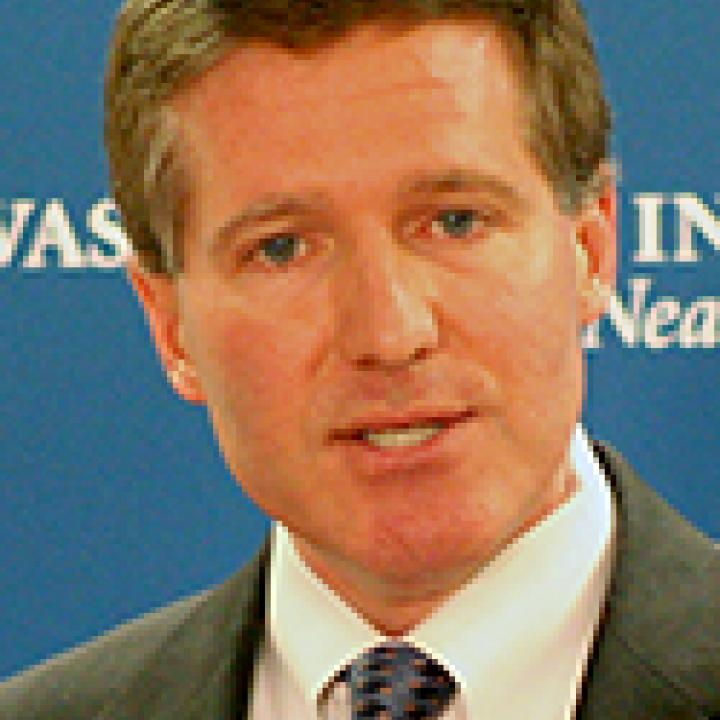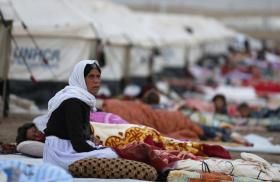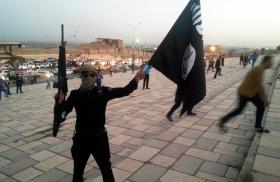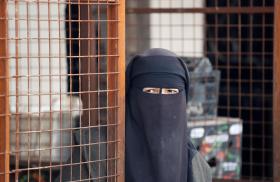
- Policy Analysis
- Counterterrorism Lecture
Tackling the Terrorist Threat: Progress Made and Future Challenges

Part of a series: Counterterrorism Lecture Series
or see Part 1: U.S. Efforts against Terrorism Financing: A View from the Private Sector
The Bush administration's outgoing homeland security advisor shares a comprehensive briefing on the state of U.S. counterterrorism since 9/11.
Homeland Security Advisor Kenneth L. Wainstein addressed a Washington Institute Policy Forum on January 7, 2009. The following is the prepared text of his remarks.
Thank you, Rob Satloff, executive director of The Washington Institute. And thank you to Mike Jacobson for setting up today's session.
I appreciate the Washington Institute -- especially the Stein Program on Counterterrorism and Intelligence -- for focusing its attention on the challenges of counterterrorism -- and for inviting me to contribute to this lecture series on those challenges. Having reviewed the list of prior speakers in your speakers' series, it's also an honor to be counted among their company.
As you heard, as Homeland Security Advisor, I have responsibility for advice and policy coordination as to all facets of the terrorism threat. Today I will focus on one aspect of this threat in particular: the risk that terrorist organizations could acquire weapons of mass destruction -- or WMD -- and use them against us, our homeland, or our allies.
Our discussion today is very timely. In less than two weeks, Barack Obama will take the oath as the 44th president of the United States, and he and his colleagues will assume responsibility for protecting America from this threat. I can assure you that, throughout this transition period, my colleagues and I are working closely with our counterparts in the new administration to ensure that they are fully equipped to carry out that responsibility starting on January 20, 2009.
Our discussion is also timely because last month, the Commission on the Prevention of Weapons of Mass Destruction Proliferation and Terrorism (WMD Commission) issued their thoughtful and comprehensive report on many of the WMD programs I will discuss today. The Commission recognized the gravity of the threat posed by weapons of mass destruction -- and in particular biological and nuclear weapons; it noted the progress the administration has made in addressing the threat; and it offered a series of important recommendations to the incoming administration. The Commission did the nation an important service by carefully analyzing this issue providing a roadmap for enhancing our ability to confront what amounts to the gravest and most immediate threat facing our nation.
So, these reasons, today is a good opportunity to step back, look at how this threat evolved, assess the defenses we have erected against this threat, and reflect on the challenges the international community will continue to face in the years to come.
The Threat: Imagining the Unimaginable
During the Cold War, terrorism and WMD proliferation were seen as two serious -- but separate -- problems. In that era, the threat of mass destruction came not from terrorists and terrorist groups, but from nation-state adversaries whose destructive ambitions could be curbed and deterred by the prospect of mutually assured destruction.
But that all changed after September 11, 2001. Those attacks highlighted the single-minded fanaticism of our adversaries, their focus on mass destruction, and their immunity from the traditional deterrence strategies that had served us well against our Cold War adversaries. We realized that a catastrophic attack was no longer solely the province of a nation-state, and that it was only a matter of time before we faced the prospect of a WMD attack from al-Qaeda or another terrorist group.
That reality was made clear when we went into Afghanistan and learned that al-Qaeda had been developing a program to cultivate and weaponize anthrax that could be used to kill by the hundreds or thousands.
And it has been made even more clear with events in the years since:
- In the fall of 2001, we suffered an attack with anthrax-laced letters that killed five, sickened seventeen others and caused somewhere in the range of $6 billion in damage to our economy.
- In December of 2001, we and the United Nations designated as a supporter of terrorism a group of Pakistani scientists and former government officials -- known as the UTN -- who had worked with the Taliban and had previously discussed nuclear, chemical, and biological weapons with Osama bin Laden.
- In 2002, we discovered an al-Qaeda laboratory in Afghanistan that was built to produce anthrax.
- In 2003, Georgian authorities seized highly-enriched uranium from a smuggler who was trying to cross the Georgian border into Armenia.
- In 2004, we and our partners undertook a concerted international effort to dismantle the A.Q. Khan network, which was, to use the words of the WMD Commission, "a one-stop shop for aspiring nuclear weapons countries."
- And in 2006, Georgian authorities again seized sensitive nuclear materials that were being smuggled across their border.
The reality of this threat has forced us to imagine the unimaginable. It has forced us consider the prospect that terrorist groups who are not deterred by the prospect of punishment or retaliation could unleash destruction of a type we had previously associated only with our Cold War adversaries. And, it has therefore forced us to expand our WMD prevention strategy from nation-state deterrence to a broader effort to deny terrorists the expertise, the components, the wherewithal and the operational stability that they need to carry out a WMD attack.
We have sought to meet that challenge by transforming our operations in two overarching ways.
Overall Counterterrorism Transformation
First, we have overhauled our overall counterterrorism program to enhance our ability to prevent terrorism of any type, no matter whether it entails weapons of mass destruction or otherwise. The architecture, organizations and operations of our counterterrorism program have changed dramatically since the attacks of 2001.
- We have stood up a number of new departments and agencies with counterterrorism capabilities, including the Department of Homeland Security, the Office of the Director of National Intelligence, the National Counterterrorism Center, NORTHCOM and the White House organization I lead, the Homeland Security Council.
- We have strengthened the counterterrorism capabilities of existing institutions -- enhancing the intelligence capacity of the FBI, developing a stronger and better-resourced human intelligence capacity at the CIA, and creating a new division devoted to attacking terrorist and proliferation financing at the Treasury Department.
- And, we have worked with Congress to develop new statutory and regulatory authorities that equip our professionals to meet the asymmetrical terrorist threat we face today. These authorities include statutes like the Patriot Act and its reauthorization, that lowered the wall that had separated our intelligence and law enforcement operations and otherwise strengthened our hand against today's terrorists, and the revised Foreign Intelligence Surveillance Act, that modernized our surveillance laws so that we can effectively monitor terrorists using today's communication technologies. They also include regulations like the new Attorney General Guidelines, that allow the FBI to blend and use both intelligence authorities and traditional law enforcement investigative tools in their effort to investigate and disrupt terrorist plots, and the new Executive Order 12333, which was recently revised to reflect the new structures in our Intelligence Community and to give our intelligence agencies clear guidance about their roles and responsibilities in the effort both to protect our nation and to protect our rule of law.
The WMD-Terrorism Strategy
In addition to these macro changes to our counterterrorism program, we have also developed and pursued a strategy specifically tailored to the WMD threat. This strategy is based on the premise that all elements of national power must be focused on the effort to undermine the terrorist capability to use WMD. To that end, this strategy prescribes six different operational objectives -- or what we call "pillars" -- that drive the formulation of our approach to WMD terrorism. Those pillars -- or operational objectives -- are:
- To use our intelligence assets and operations effectively to learn the enemy's thinking and plans for the use of WMD.
- To stop terrorists from getting access to WMD-related materials, expertise, and other enabling technologies.
- To strengthen deterrence by making clear the consequences of any WMD attack.
- To detect the movement of WMD-related materials, weapons and personnel and disrupt specific terrorist plots as they unfold.
- To respond and recover effectively if we are, in fact, attacked.
- And finally, to have the capacity to identify the perpetrator of any WMD attack, so that we can develop our strategic response quickly and effectively.
These are straight-forward objectives, but we have long recognized that we can accomplish them only if we work cooperatively with all parties to this effort. And, that cooperative approach is evident in our operations both domestically and overseas.
On the domestic front, we have devised new governmental structures that are designed specifically to ensure cooperation and the sharing of information among all of the relevant agencies.
- For instance, we established the National Counterproliferation Center, with the charge to coordinate strategic planning for intelligence regarding WMD proliferators, to identify critical gaps in collection and analysis, and to develop solutions to fix those shortfalls.
- The FBI established a new WMD Directorate to consolidate and leverage the Bureau's WMD and counterproliferation initiatives and resources.
- And at the White House, we created a joint policy coordination committee to harmonize the counterterrorism and counterproliferation policy agendas and focus them on the implementation of the president's WMD-terrorism strategy across the government.
We have also worked hard to develop cooperative efforts across borders with our foreign partners. Thanks to dedicated and effective diplomacy by President Bush and others, we and our allies are now jointly involved in a number of international initiatives and multilateral coalitions that greatly enhance our global collective ability to combat WMD terrorism. Thanks to these diplomatic efforts -- and the willing cooperation of so many of our foreign allies and friends -- America now has more partners, in more regions of the world, who are doing more to help keep our people safe from WMD terrorism.
These efforts at home and abroad have allowed us to make tremendous progress in the effort against weapons of mass destruction and particularly as to the two types that pose the most immediate threat of catastrophic harm to the United States -- nuclear and biological weapons of mass destruction.
The Nuclear Threat
On the nuclear front, we have made strides all along the preventive continuum -- preventing nascent plots by denying terrorists access to nuclear materials in the first place to detecting and disrupting terrorist operations once they are in train.
The effort to deny terrorists access to nuclear expertise and materials has truly been a group effort over the years, based on the cooperative efforts of many international partners.
One such partnership is the Bratislava Initiative. Through this initiative, the Departments of Defense and Energy have worked closely with Russia and a number of other countries, including former Soviet states, to improve their security and accounting of nuclear materials -- an effort that has entailed, for example, the installation of security fences and high-technology sensors at nearly 150 sites that store nuclear weapons and fissile material.
In another cooperative effort, we have worked with Russia to reduce the legacy nuclear stockpiles of the Cold War, by downblending more than 350 metric tons of highly-enriched uranium from Russian nuclear weapons. This material -- that could have created about 14,000 nuclear warheads -- is instead being used as reactor fuel that helps to generate around 10 percent of the electricity we use here in the United States.
Another cooperative effort is the Global Initiative to Combat Nuclear Terrorism that we launched with the Russians in 2006 -- an initiative that builds the operational capacity to improve security and disrupt nuclear smuggling, the legal capacity to prosecute cases involving nuclear threats and materials, and the response and recovery capacity to mitigate the consequences of an actual attack. Today, seventy-five nations are partners in this initiative.
In addition to our efforts to secure and keep nuclear materials from the terrorists, we have also developed a stronger capacity to detect and intercept such materials if and when terrorists succeed in procuring them.
In 2005, we established the Domestic Nuclear Detection Office within the Department of Homeland Security to develop and coordinate a global nuclear detection architecture to identify and act on illicit attempts to store, develop, or transport nuclear or radiological material for use against the Homeland.
In addition, through innovative programs such as the Container Security Initiative and the Megaports program, we and our partners are installing radiation detection equipment around the world that is helping to detect and interdict dangerous nuclear materials as they are in transit. Thanks to the use of such equipment both here and abroad, 98 percent of all incoming seaborne containerized cargo is being scanned for radiological material; 100 percent of the container traffic entering the U.S. on the Southern border is being scanned; and 95 percent of the container traffic entering the U.S. on the Northern border is being scanned.
Moreover, we have increased our capabilities and resources devoted to the mission of locating, diagnosing, and disabling a WMD device in the event that one makes its way into the United States. This mission was originally assigned to the Department of Defense. Over the past three years, the FBI has assumed responsibility for this vital mission. The Bureau continues to increase and refine these capabilities -- by, for example, training and improving its response time to a suspected WMD device -- while the Defense Department stands ready to provide support if and where needed.
The Biological Threat
Much work has also been done to prevent terrorists from striking us with a biological weapon of mass destruction -- a deadly bacterium like anthrax, a virus like smallpox, or a toxin like ricin that could kill thousands of Americans if prepared and disseminated correctly.
Like our work in the nuclear arena, our efforts on the biological threat begin with cooperation with Russia and with the states of the former Soviet Union. Through a number of cooperative efforts, we are working together to eliminate the biowarfare infrastructure that developed during the Cold War, to consolidate and secure dangerous biological materials, to enhance biosafety and biosecurity, to redirect former Soviet biological weapons scientists to peaceful employment and to reconfigure former bioweapons facilities for the development of drugs and vaccines.
These efforts extend far beyond the former Soviet Union and to developing nations in every continent -- particularly to nations that face significant risks from transnational terrorist groups or that have poorly secured biological laboratories.
These efforts to secure dangerous pathogens also extend here to the United States, where there has been a well-deserved focus placed on laboratory security since last summer when the FBI identified the 2001 anthrax killer as Dr. Bruce Ivins, a government biodefense science who worked at the U.S. Army biodefense research laboratory at Fort Detrick, Maryland. That incident prompted an exhaustive Department of Defense review and upgrade of its security and personnel assurance practices.
It has also led to a more comprehensive effort to review and enhance the security measures at laboratories that handle dangerous biological agents and toxins. In fact, as we end our final weeks in office, we continue our work in this field. We are establishing an interagency working group of government experts in the scientific and security community to make recommendations to the next president in the coming months to further enhance security in our nation's biological laboratories.
Beyond working to secure dangerous pathogens, we have improved our ability to mitigate the effects of a biological attack.
- We have launched a program to improve early detection of biological attacks, with the installation of a state-of-the-art air monitoring system in 30 U.S. cities that can detect the release of biological agents.
- We have taken steps to develop and ensure ample supplies of countermeasures in the event of an attack. We now have enough smallpox vaccine to inoculate every American, and we have greatly expanded our inventories of other vaccines and medical countermeasures we would use in case of a bioterrorist attack or pandemic.
- We have increased biodefense research and development at the National Institutes of Health from $53 million in 2001 to more than $1.6 billion today.
- And we launched Project BioShield -- an effort to speed the development of new vaccines and treatments against biological agents that could be used in a terrorist attack.
WMD Deterrence
On a broader level, beyond the defenses we have built against the nuclear and biological threat, we have also made progress in reshaping how we and our allies deter persons, networks, states and organizations from engaging in any conduct that contributes to the terrorist use of weapons of mass destruction.
While it is difficult to deter today's terrorists with the traditional notion of punishment or retribution, there are other means of achieving deterrence.
For instance, we know that al-Qaeda and terrorist leadership and operatives actually care about the perceived theological, moral, and political legitimacy of their actions, especially within Muslim communities. This is why encouraging debate, especially among credible voices, about the legitimacy of using weapons of mass destruction is important and can affect the intentions and planning of terrorists.
We also know that deterrent measures can gain purchase against states, organizations or facilitators who may assist terrorists in their efforts to acquire or use WMD -- measures such as the designation of proliferation facilitators or financiers under Executive Order 13382, which was issued in 2005. This tool allows the secretaries of Treasury or State to freeze the assets and block the transactions of the designated individuals or entities, resulting in their isolation from the worlds of legitimate commerce and finance.
A strong deterrence also involves constantly reinforcing the declaratory policy that was first enunciated early last year by National SecurityAdvisor Steve Hadley -- which is the statement of principle that we reserve the right to respond with overwhelming force to the use of weapons of mass destruction against the United States, our people, our forces, and our friends and allies; and that we will hold any state, terrorist group, or other non-state actor fully accountable for supporting or enabling terrorist efforts to obtain or use weapons of mass destruction -- whether by facilitating, financing, or providing expertise or safe haven for such efforts.
While no deterrence strategy is foolproof when dealing with modern terrorists, these measures have an impact, and I recommend that they be maintained and strengthened in the future.
Conclusion
In sum, it is clear that our Nation has made considerable progress in combating the threat of WMD terrorism. Absent the president's commitment to this mission, his ability to imagine the unimaginable of WMD terrorism, and the work of the last eight years, the report from the WMD Commission might have been much starker and the world of today might look much different.
- There would be no comprehensive strategy to meet the threat of WMD terrorism, along with the corresponding investments in institutions, defenses, countermeasures and implementing policies.
- There would be no international consensus with multilateral coalitions addressing the WMD threat through cooperation and vigorous enforcement.
- And absent these efforts, Libya would still be developing its WMD programs and the A.Q. Khan network would still be sharing the world's most dangerous secrets and equipment with rogue actors.
We appreciate the WMD Commission for recognizing these efforts and the strategy with which this Administration has confronted the WMD terrorism threat. We also appreciate its assessment that much more work needs to be done -- and that we must continue to build our defenses and adapt our strategy to meet the evolving threat posed by terrorist groups and their WMD ambitions.
We urge the next administration to follow the lead set by this administration and by the WMD Commission. They are inheriting a comprehensive WMD strategy, one that is being implemented by strong counterterrorism institutions, far-reaching initiatives and cooperative international relationships. This is a firm foundation, and I look forward to seeing it develop into an increasingly formidable bulwark that will continue to protect our country and our people from catastrophic attacks of the type that truly are unimaginable.





